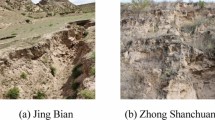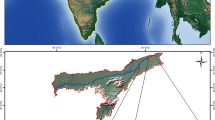Abstract
In order to investigate changes caused in clay mineralogy and potassium (K) status by different land-use types, 42 soils samples (0–30 cm) were monitored and analyzed. Soil samples belonging to Reference Soil Groups of Cambisols and Vertisols were collected from three neighboring land uses involving cropland (under long-term continuous cultivation), grassland, and forestland. The soils reflected an alkaline and calcareous aspect as were characterized by high pH (mean of 7.1 to 7.5) and calcium carbonate equivalent (mean of 35 to 97 g kg−1) in the three land-use types. X-ray diffraction patterns of the clay fraction showed that the soils were mainly composed of illite, smectite, chlorite, and kaolinite. Chlorite and kaolinite remained unweathered irrespective of land use and soil types, soil processes, and physicochemical attributes assessed. Some changes in the XRD diffractograms of illite and smectite (the intensity or the position of peaks) were observed in the cultivated soils compared to those of the adjoining grassland that may explain the dynamics of the K trapped in illite interlayer sites. Potassium issues reflected a heterogeneous response to changes in land-use types. In light of this, a pronounced variation in soluble K (4–22 mg kg−1), exchangeable K (140–558 mg kg−1), and non-exchangeable K (135–742 mg kg−1) appeared among the land-use types for both Cambisols and Vertisols, corresponding to variability in clay content, nature and type of clay mineral (mainly illite and smectite), cation exchange capacity (CEC), and soil organic carbon (SOC). In general, the largest amounts of soluble K and exchangeable K were recorded in the forestland, whereas the highest contents of non-exchangeable K were found in the grassland for both Cambisols and Vertisols. Exchangeable K, available K, CEC, and clay contents in the soils with higher smectite values (25–50 %) were significantly different (P ≤ 0.05) compared to those of the lower smectite values (10–25 %). This suggests that smectite is a major source for surface sorption of K in the studied soils.






Similar content being viewed by others
References
Abbasi MK, Zafar M, Razaq Khan S (2007) Influence of different land-cover types on the changes of selected soil properties in the mountain region of Rawalakot Azad Jammu and Kashmir. Nutr Cycl Agroecosyst 78:97–110
Andrist-Rengel Y (2008) Quantifying mineral sources of potassium in agricultural soils. Doctoral Diss., Dept. of Soil and Environment, SLU. Acta Unversitatis Agriculturae Sueciae, Uppsala, Sweden. Available at http://epsilon.slu.se/eng/index.html
Barre P, Berger G, Velde B (2009) How element translocation by plants may stabilize illitic clays in the surface of temperate soils. Geoderma 151:22–30
Biscaye PE (1965) Mineralogy and sedimentation of recent deep-sea clay in the Atlantic Ocean and adjacent seas and oceans. Geol Soc Am Bull 76:803–832
Brady NC, Weil RR (1999) The nature and properties of soils. 12th Ed. Prentice-Hall, pp 881
Chapman HD (1965) Cation exchange capacity. In: Black CA (ed) Methods of Soil Analysis, Part 2. American Society of Agronomy, Madison, Wisconsin, pp 891–900
Day PR (1965) Particle fractionation and particle-size analysis. In: Black CA (ed) Methods of Soil Analysis, Part 1. American Society of Agronomy, Madison, Wisconsin, pp 545–566
FAO (2006) Guidelines for soil description, 4th edn. Food and agriculture organization of the United Nations, Rome, Italy
FAO/ISRIC/ISSS (2006) World Reference Base for Soil Resources (WRB). Food and agriculture organization of the United Nations. World Soil Resources reports no. 103. ISRIC and ISSS, Rome, Italy
Hein JR, Dowling JS, Schuetze A, Lee HJ (2003) Clay-minerals suites, sources, and inferred dispersal routes: Southern California continental shelf. Mar Environ Res 56:79–102
Hinsinger P (2002) In: Lal R (ed) Encyclopedia of soil science. Marcel Dekker, Inc, New-York, USA
Hinsinger PH, Jaillard B (1993) Root-induced release of interlayer potassium and vermiculization of phlogopite as related to potassium depletion in the rhizosphere of ryegrass. J Soil Sci 44:525–534
Kleber M, Schwendenmann L, Veldkamp E, Rossner J, Jahn R (2007) Halloysite versus gibbsite: silicon cycling as a pedogenetic process in two lowland neotropical rain forest of La Selva, Costa Rica. Geoderma 138:1–11
Knudsen D, Peterson GA, Pratt PF (1982) Lithium, sodium, and potassium. In: Page AL (ed) Methods of Soil Analysis, Part 2. American Society of Agronomy, Madison, Wisconsin, pp 225–246
Mehra OP, Jackson ML (1960) Iron oxide removal from soils and clays by a dithionite citrate system with sodium bicarbonate. Clay Clay Miner 7:317–327
Nelson RE (1982) Carbonate and gypsum. In: Page AL (ed) Methods of soil analysis, part 2. American Society of Agronomy, Madison, Wisconsin, pp 181–199
Nelson DW, Sommers LE (1982) Total carbon, organic carbon, and organic matter. In: Page AL (ed) Methods of soil analysis, part 2. American Society of Agronomy, Madison, Wisconsin, pp 539–580
Nelson DW, Sommers LE (1998) Total nitrogen analysis for soil and plant tissues. J Assoc Off Anal Chem 63:770–778
Nilawonk W, Attanandana T, Phonphoem A, Yost R, Shuai X (2008) Potassium release in representative maize-producing soils of Thailand. Soil Sci Soc Am J 72:791–797
Olsen SR, Sommers LE (1982) Phosphorus. In: Page AL, Miller RH, Keeney DR (eds) Methods of soil analysis, part 2. American Society of Agronomy, Madison, Wisconsin, pp 403–430
Rezapour S, Samadi A (2011) Assessment of inceptisols soil quality following long-term cropping in a calcareous environment. Environ Monit Assess. doi:10.1007/s10661-011-2042-6
Rezapour S, Jafarzadeh AA, Samadi A, Oustan Sh (2009a) Study of climatic effects on soil genesis and clay mineralogy in the west Azarbaijan Province. Ph.D thesis, Tabriz University, Iran
Rezapour S, Jafarzadeh AA, Samadi A, Oustan S (2009b) Impacts of clay mineralogy and physiographic units on the distribution of potassium forms in calcareous soils in Iran. Clay Miner 44:329–339
Samadi A, Dovlati A, Barin M (2008) Effect of continuous cropping on potassium forms and potassium adsorption characteristics in calcareous soils of Iran. Aust J Soil Res 46:265–272
Sharma BD, Mukhhopadhyay SS, Sawhney JS (2006) Distribution of potassium fractions in relation to landforms in a Himalayan catena. Arch Agron Soil Sci 52:469–476
Sharma A, Jalali VK, Arora S (2010) Non-exchangeable potassium release and its removal in foot-hill soils of North-west Himalayas. Catena 82:112–117
Singh B, Goulding KWT (1997) Changes with time in the potassium content and phyllosilicates in the soil of the Broadbalk continuous wheat experiment at Rothamsted. Eur J Soil Sci 48:651–659
Sparks DL (1987) Potassium dynamics in soils. Adv Soil Sci 6:1–63
Srinivasa Rao CH, Khera MS, Subba Rao A (1994) Soil potassium depletion and K replenishment capacity of soils under intensive cropping. J Potassium Res 10:229–235
Srinivasa Rao CH, Vittal K, Tiwari KN, Gajbhiye PN, Kundu SU (2007) Categorisation of soils based on potassium reserves and production system: implications in K management. Aust J Soil Res 45:438–477
Thomas GW (1982) Exchangeable cations. In: Page AL, Miller RH, Keeney DR (eds) Methods of soil analysis, part 2. American Society of Agronomy, Madison, Wisconsin, pp 159–166
Timpson ME, Lee SY, Ammons JT, Foss JE (1996) Mineralogical investigation of soils formed in calcareous gravelly alluvial, eastern Crete, Greece. Soil Sci Soc Am J 60:299–308
Tripler CE, Kaushal SS, Likens GE, Walter MT (2006) Patterns in potassium dynamics in forest ecosystems. Ecol Lett 9:451–466
Van Scholl L, Kuyper TW, Smits MM, Landeweert R, Hoffland E, Van Breemen N (2008) Rock-eating mycorrhizas: their role in plant nutrition and biogeochemical cycles. Plant and Soil 303:35–47
Velde B, Peck T (2002) Clay mineral changes in the Morrow experimental plots, University of Illinois. Clay Clay Miner 50:364–370
Wang JG, Zhang FS, Zhang XL, Cao YP (2000) Release of potassium from K-bearing minerals: effect of plant roots under P deficiency. Nutr Cycl Agroecosyst 56:45–52
Wang J, Fu B, Qiu Y, Chen L (2001) Soil nutrients in relation to land use and landscape position in the semi-arid small catchment on the loess plateau in China. J Arid Environ 48:537–550
Young WJ, Marston FM, Davis RJ (1996) Nutrient exports and land use in Australian catchments. J Environ Manage 47:165–183
Acknowledgment
The authors gratefully acknowledge Urmia University and the Iran National Science Foundation for the financial support of this research project.
Author information
Authors and Affiliations
Corresponding author
Rights and permissions
About this article
Cite this article
Rezapour, S., Samadi, A. The spatial distribution of potassium status and clay mineralogy in relation to different land-use types in a calcareous Mediterranean environment. Arab J Geosci 7, 1037–1047 (2014). https://doi.org/10.1007/s12517-012-0746-8
Received:
Accepted:
Published:
Issue Date:
DOI: https://doi.org/10.1007/s12517-012-0746-8




